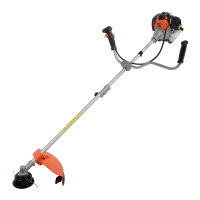5352
OPERATION
OPERATION
OPERATION
1. Check the bolt to fasten the blade and be sure the bolt has
no faults or damage.
2. Be sure that the blade and the holder have been fastened
according to instruction and that the blade turns smoothly
without abnormal noise.
The rotating parts fastened incorrectly may cause serious
injury to the operator.
Make sure that the blade is not bent, warped, cracked, broken
or damaged.
If you nd any error to the blade, discard it and replace with a
new one.
Make sure to use the harness and cutting attachment guard.
If not, it is very dangerous when you slip or lose your balance.
TRANSPORTING THE UNIT
• When you nish cutting in one location and wish to
continue work in another spot, turn off the engine, lift up
the unit and carry it, paying attention to the blade.
• Never forget to place the protective cover over the blades
while transporting.
• When transporting the unit over long distances, detach
the blade and fasten the unit by ropes.
STORING THE UNIT
• Always drain the machine of fuel before long or short term
storage.
• Run dry by emptying the fuel tank, starting the engine and
running until the machine stops.
• Running the machine dry of any fuel will prevent blockages
within the fuel system and ensure an easy start when next
in use.
CONTROLLING BLADE THRUST
Blade thrust can cause serious personal injury. Carefully study
this section. It is important that you understand what causes
blade thrust, how you can reduce the chance of it, and how
you can remain in control of the unit if blade thrust occurs.
WHAT CAUSES BLADE THRUST?
• Blade thrust can occur when the moving blade come
in contact with an object that it cannot cut. This contact
causes the blade to stop for an instant and then suddenly
move or "bounce" away from the object that was hit. The
operator can lose control of the unit and the blade can
cause serious personal injury to the operator, or any
person nearby if the blade contacts any part of the body.
HOW YOU CAN REDUCE THE CHANCE OF BLADE
THRUST?
• Recognise that the blade thrust can happen. By
understanding and knowing about blade thrust you can
help eliminate the element of surprise
• Cut brous weeds and grass only. Do not let the blade
contact materials it cannot cut such as hard, woody vines,
and bushes or rocks, fences, metal etc.
• Be extra prepared for thrust if you must cut where you
cannot see the blade making contact such as in areas of
dense growth.
• Keep the blade sharp. A dull blade increases the chance
of thrust.
• Avoid feeding the blade too rapidly. The blade can bounce
away from material being cut if the blade is fed faster than
its cutting capability.
• Cut only from your right to your left.
HOW YOU CAN MAINTAIN CONTROL?
• Keep a good, rm grip on the unit with both hands. A rm
grip can help neutralise thrust. Keep your right and left
hands completely around the respective handles.
• Keep both feet spread apart in a comfortable stance and
yet braced for the possibility that the unit could bounce. Do
not overreach. Keep rm footing and balance.

